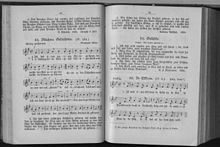Ich hab mich ergeben
| English: 'I Have Surrendered' | |
|---|---|
 The text in an album titled Gelübde | |
Former national anthem of West Germany | |
| Also known as | „Gelübde“ (English: 'Vow') |
| Lyrics | Hans Ferdinand Maßmann, 1820 |
| Music | August Daniel von Binzer, 1819 |
| Adopted | 1949 |
| Relinquished | 1952 |
| Preceded by | "Deutschlandlied" and "Horst-Wessel-Lied" (by Germany) |
| Succeeded by | "Deutschlandlied" |
| Audio sample | |
U.S. Navy Band instrumental rendition in F major | |
"Ich hab mich ergeben" (German: [ɪç hap mɪç ɛʁˈɡeːbən]; lit. 'I Have Surrendered'), originally titled "Gelübde" (IPA: [ɡəˈlʏbdə]; 'Vow'), is a German patriotic song. The text was written in 1820 by Hans Ferdinand Maßmann. It was one of the unofficial national anthems of West Germany from 1949 until 1952, when the "Deutschlandlied" was officially reinstated.[1] Its tune is now used in the Micronesian national anthem.
History
[edit]The national anthem of the Federated States of Micronesia, "Patriots of Micronesia", uses the same tune,[2] as does the Estonian song "Mu Isamaa armas" ("My beloved native land" by Martin Körber) which used to be Estonia's official flag song until 2009 when it was replaced by Gustav Ernesaks's "Mu Isamaa on minu arm" ("My homeland is my love").[3][4] The Latvian song "Šie kauli, šī miesa" also has the same tune. The melody is quoted by Johannes Brahms in his Academic Festival Overture.[5] The Deutschlandfunk used the motif to the words "dir Land voll Lieb und Leben" as its interval signal.
The second stanza includes the words "land of the free", similar to the well-known words of "The Star-Spangled Banner", written eight years earlier.
Lyrics
[edit]| German original | English translation |
|---|---|
I | I |
Melody
[edit]
Arrangement: Friedrich Gernsheim: "125 Gelübde", in Volksliederbuch für Männerchor, vol. 1, Leipzig, C. F. Peters 1906.
"Wir hatten gebauet"
[edit]The music had originally been composed for another patriotic song by August Daniel von Binzer, "Wir hatten gebauet ein stattliches Haus" (1819).[6] Some sources state that in this song the colours Black, Red, and Gold are mentioned for the first time in this order which is not true. In 1817, Binzer had written a different song that begins with the words "Stoßt an! Schwarz-Rot-Gold lebe!" (Let's toast! May Black, Red and Gold live!)[7]
The song's first performance took place on 27 January 1819 after the forced dissolution of the Urburschenschaft.[8] Around one year later, he wrote it down in the register of the participants of the 1817 Wartburg Festival.[9] There, he called the tune a "Thuringian folk song", but no evidence of such earlier melody exists. The lyrics were published for the first time in the Kieler Commers- und Liederbuch in 1821, the tune followed in 1825.[10]
The text refers to the dissolution of the Urburschenschaft ("A noble house") due to the Carlsbad Decrees. During the Vormärz, censorship often replaced the colours with lines.[11]
| German original | English translation |
|---|---|
I | I |
References
[edit]- ^ Applegate, Celia (ed.). Music and German National Identity. University of Chicago Press. 2002. p. 263.
- ^ Frédéric Bisson, Comment bâtir un monde, Les Éditions Chromatika, 2011, p. 140.
- ^ "Kommentaar: Mõned ääremärkused Eesti lipulaulu asjus". www.eesti.ca.
- ^ "Mu Isamaa Armas" – via www.youtube.com.
- ^ Freeze, Timothy David (2010). Gustav Mahler's Third Symphony: Program, Reception, and Evocations of the Popular (dissertation). University of Michigan. pp. 216–217. Retrieved 2014-04-25.
- ^ Monelle, Raymond. The Musical Topic: Hunt, Military and Pastoral. Indiana University Press, 2006. P. 257.
- ^ Grünebaum, Falk. "Deutsche Farben. Die Entwicklung von Schwarz-Rot-Gold unter besonderer Berücksichtigung der Burschenschaft". In: GDS-Archiv für Hochschul- und Studentengeschichte. Vol. 7. Köln, 2004. P. 21.
- ^ Grünebaum, Falk. "Deutsche Farben. Die Entwicklung von Schwarz-Rot-Gold unter besonderer Berücksichtigung der Burschenschaft". In: GDS-Archiv für Hochschul- und Studentengeschichte. Vol. 7. Cologne, 2004. P. 23.
- ^ "Binzer's entry in the Wartburg Festival register", liederlexikon.de
- ^ Tobias Widmaier (2011). "Ich hab mich ergeben". Populäre und traditionelle Lieder. Historisch-kritisches Liederlexikon (analysis, editions) (in German).
- ^ "Edition B: Erstdruck mit Melodie 1825 — Liederlexikon". www.liederlexikon.de.
External links
[edit] Media related to Ich hab mich ergeben at Wikimedia Commons
Media related to Ich hab mich ergeben at Wikimedia Commons- "Ich hab mich ergeben", text, notes chords; Alojado Lieder Archiv
- "Ich hab mich ergeben", ingeb.org


 French
French Deutsch
Deutsch